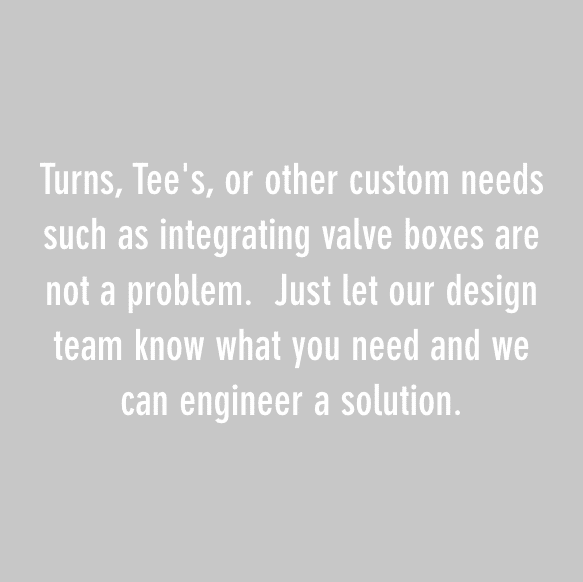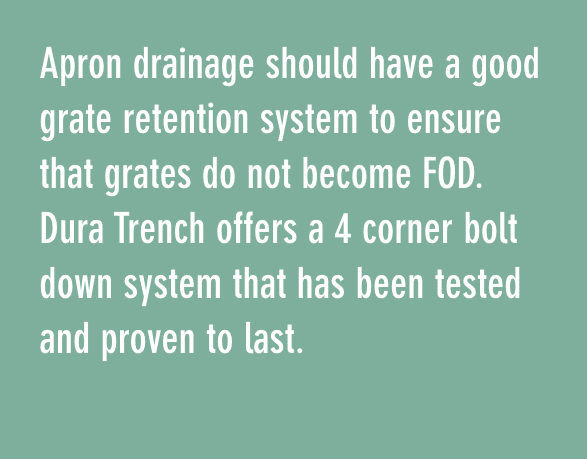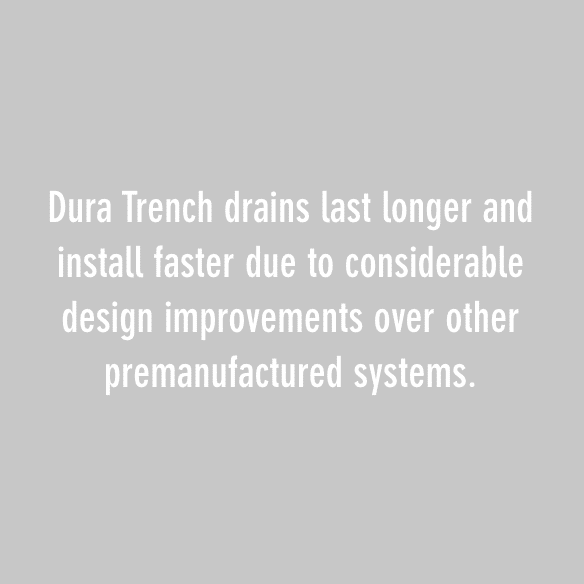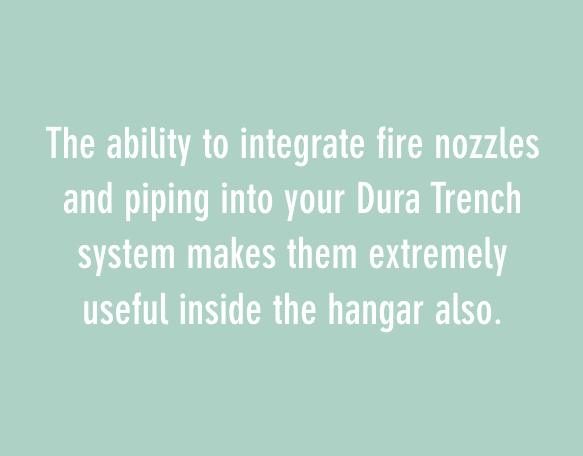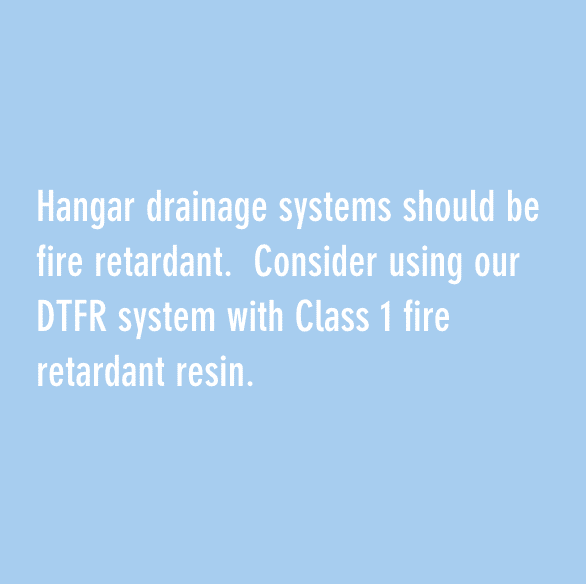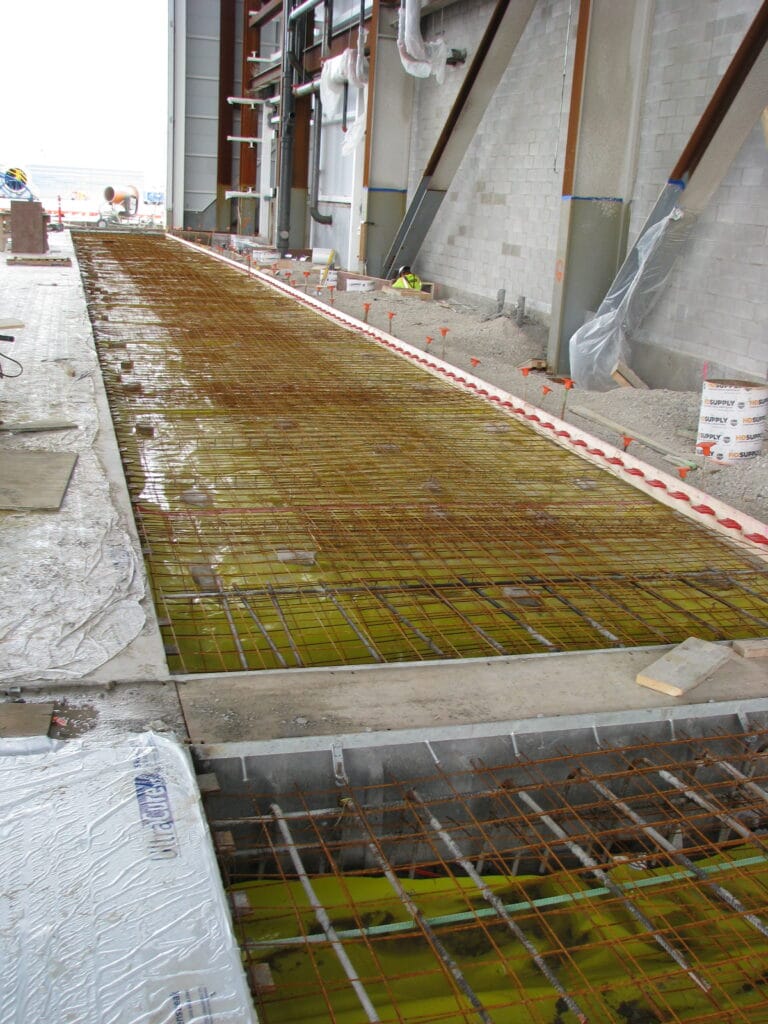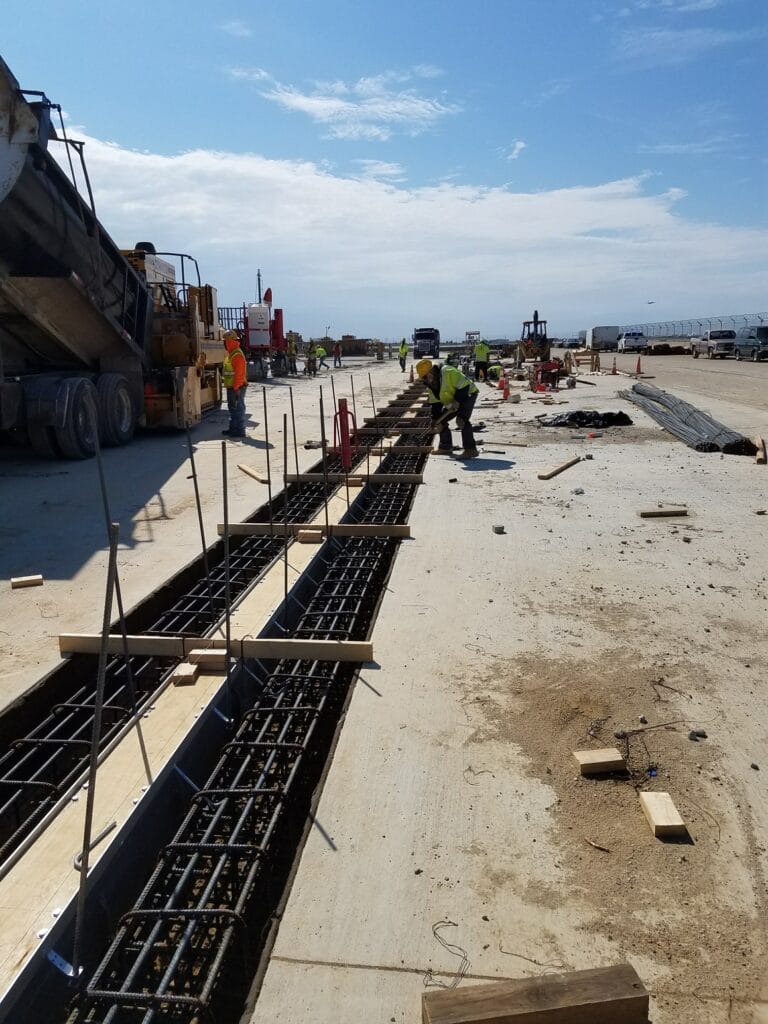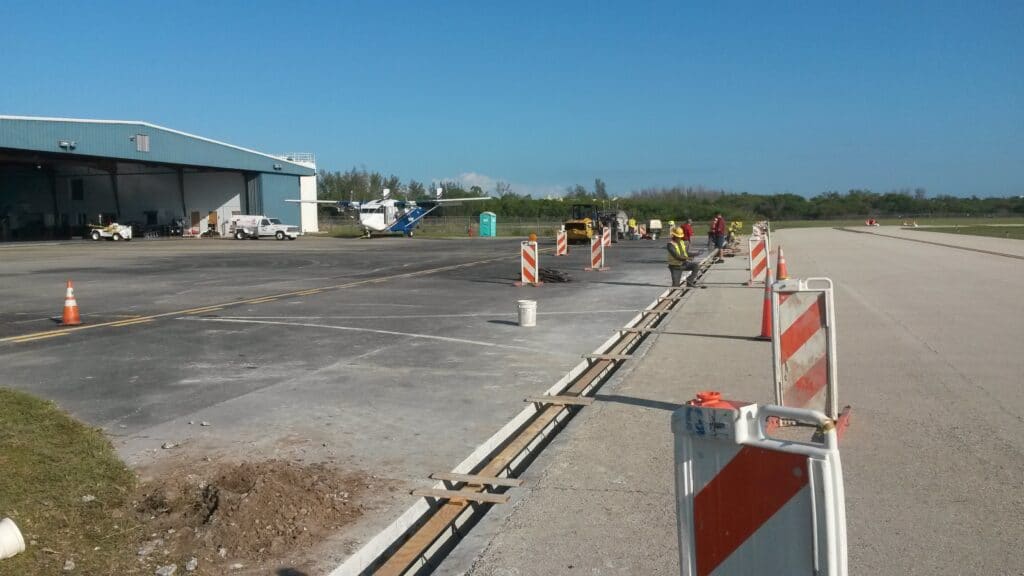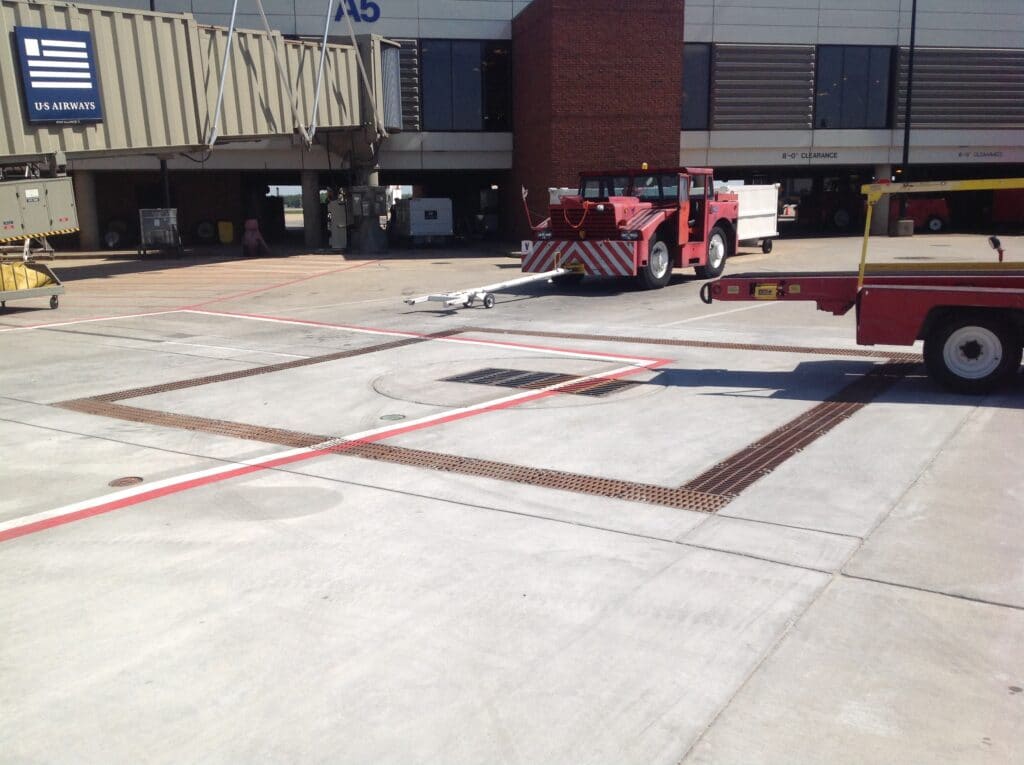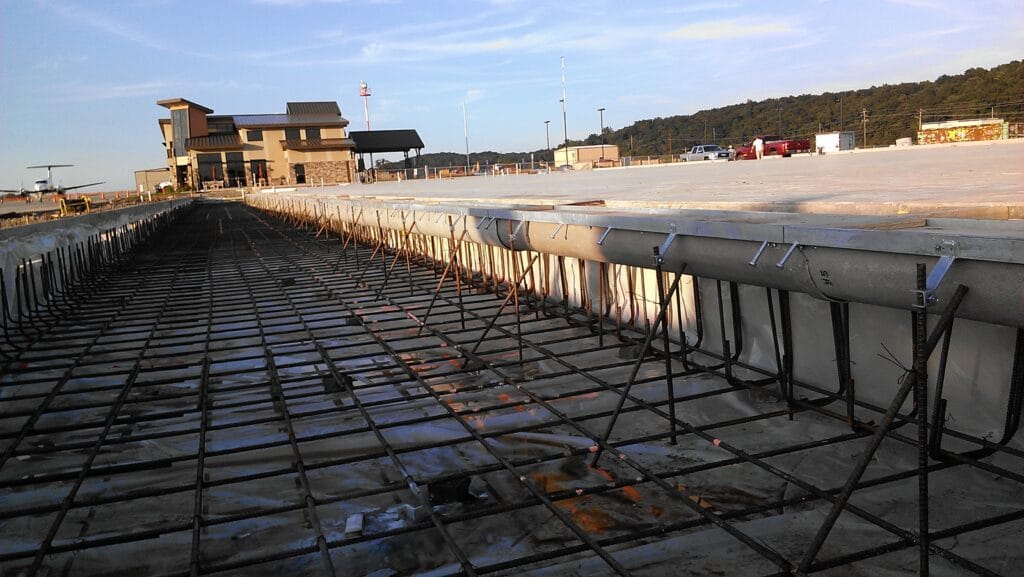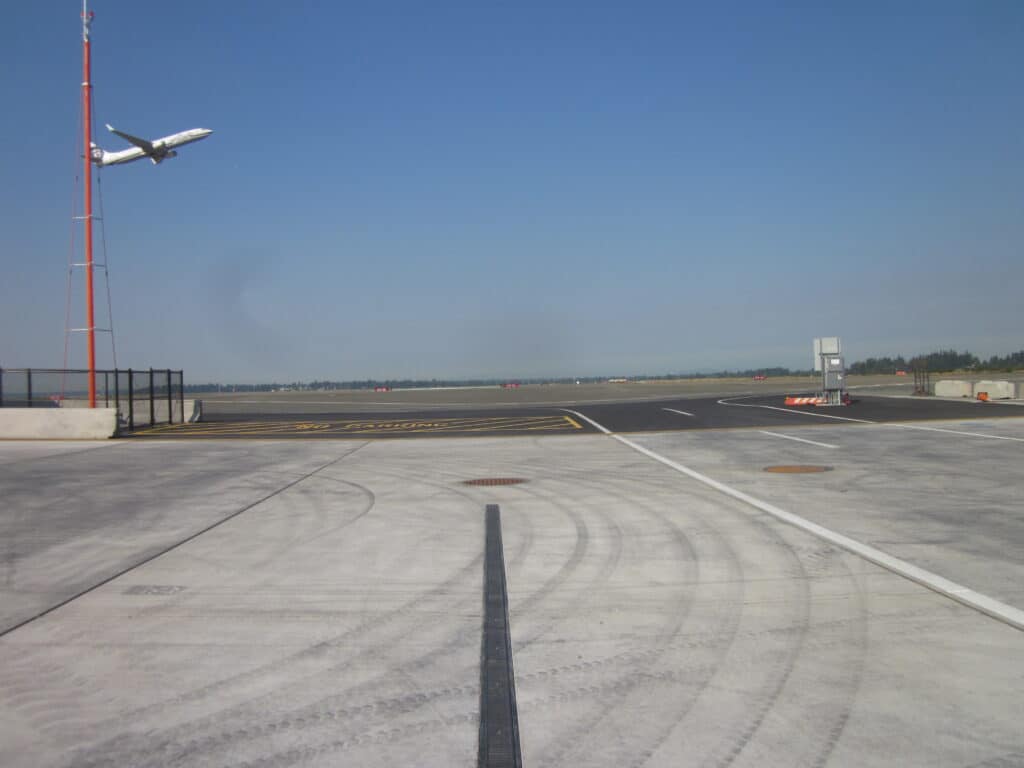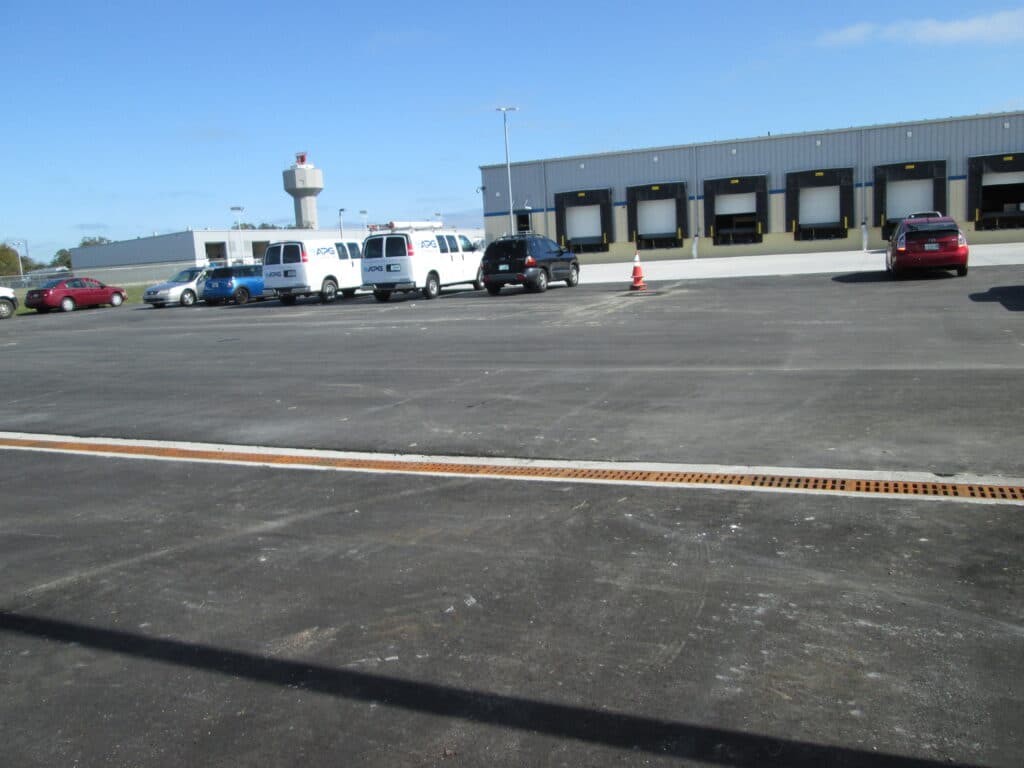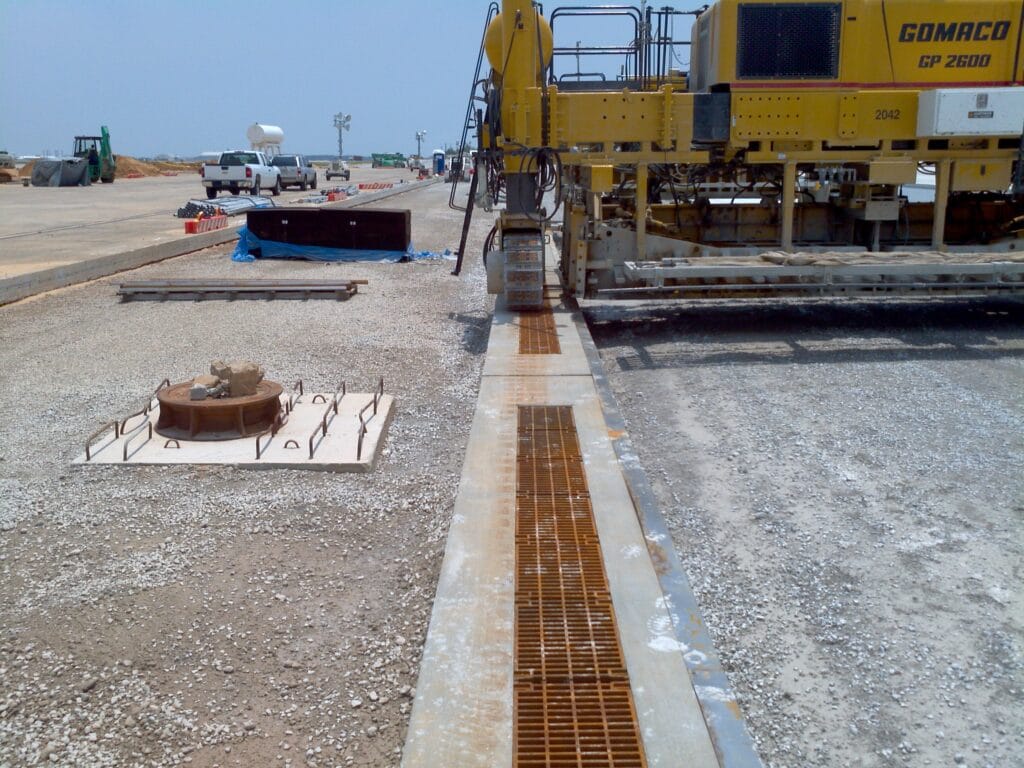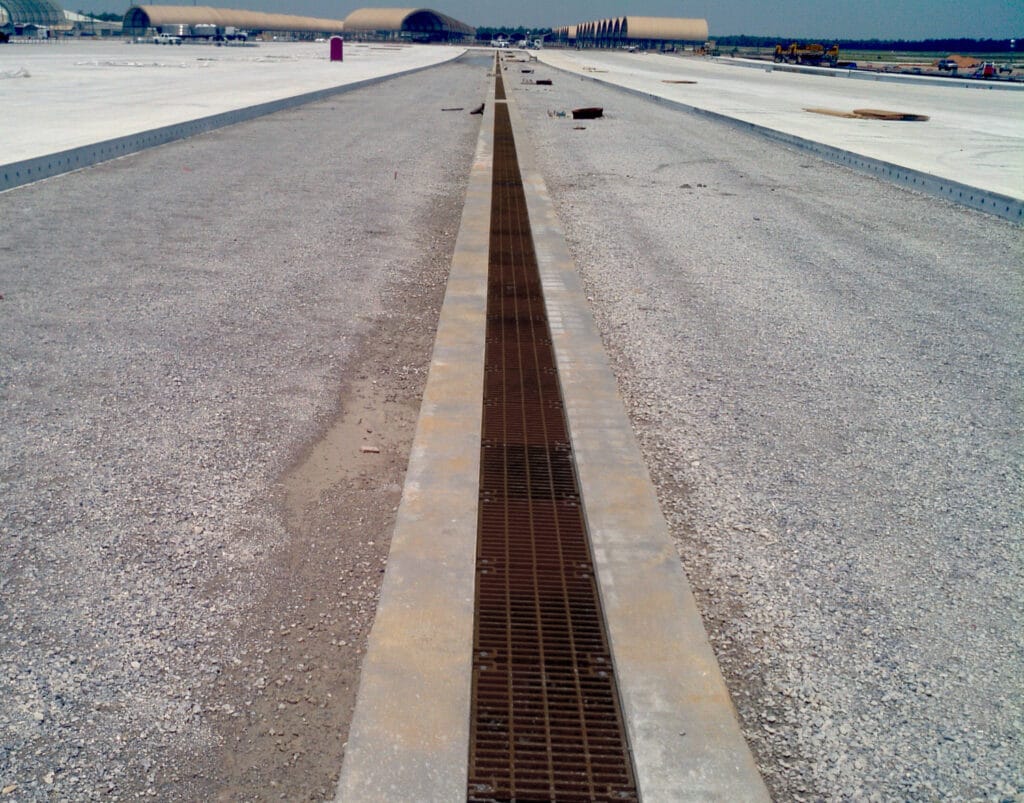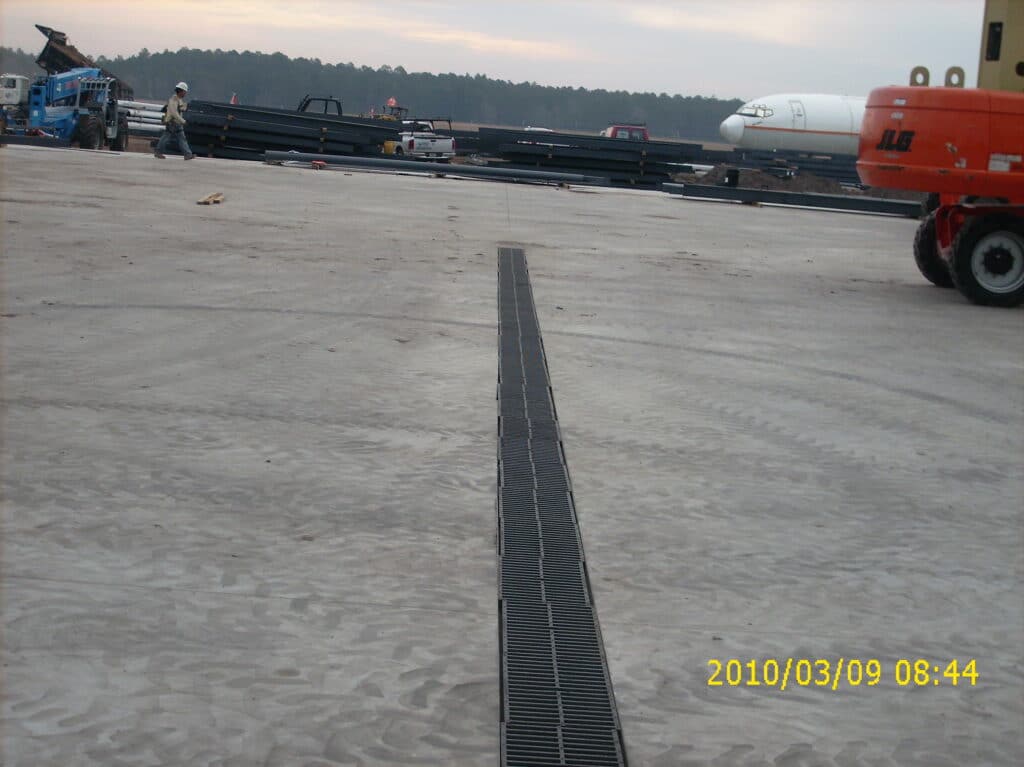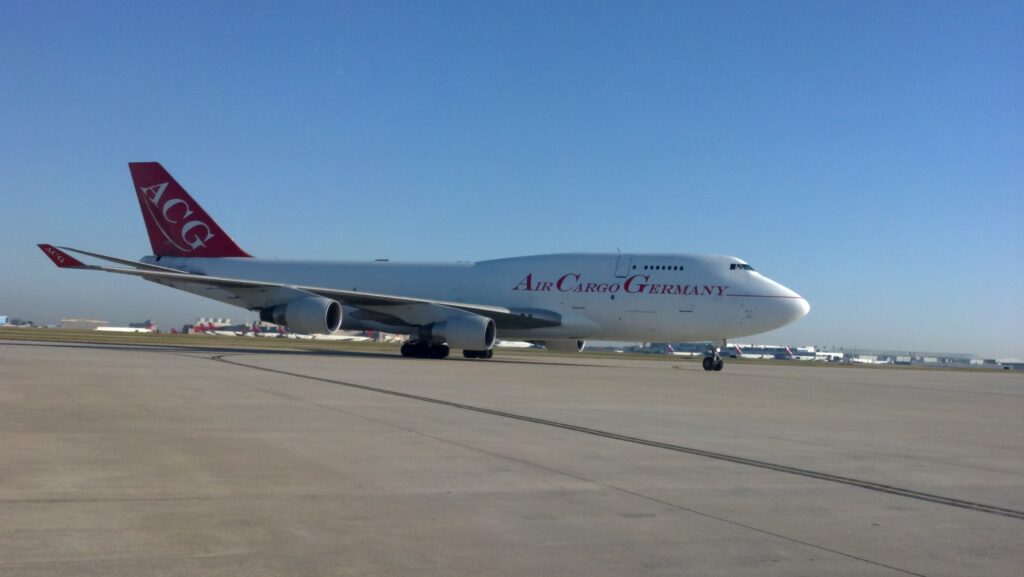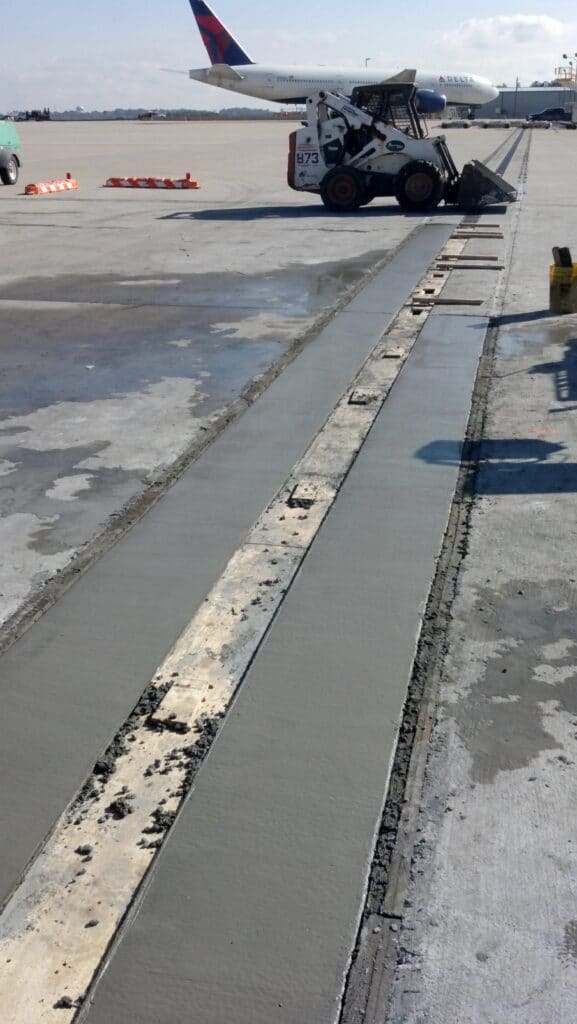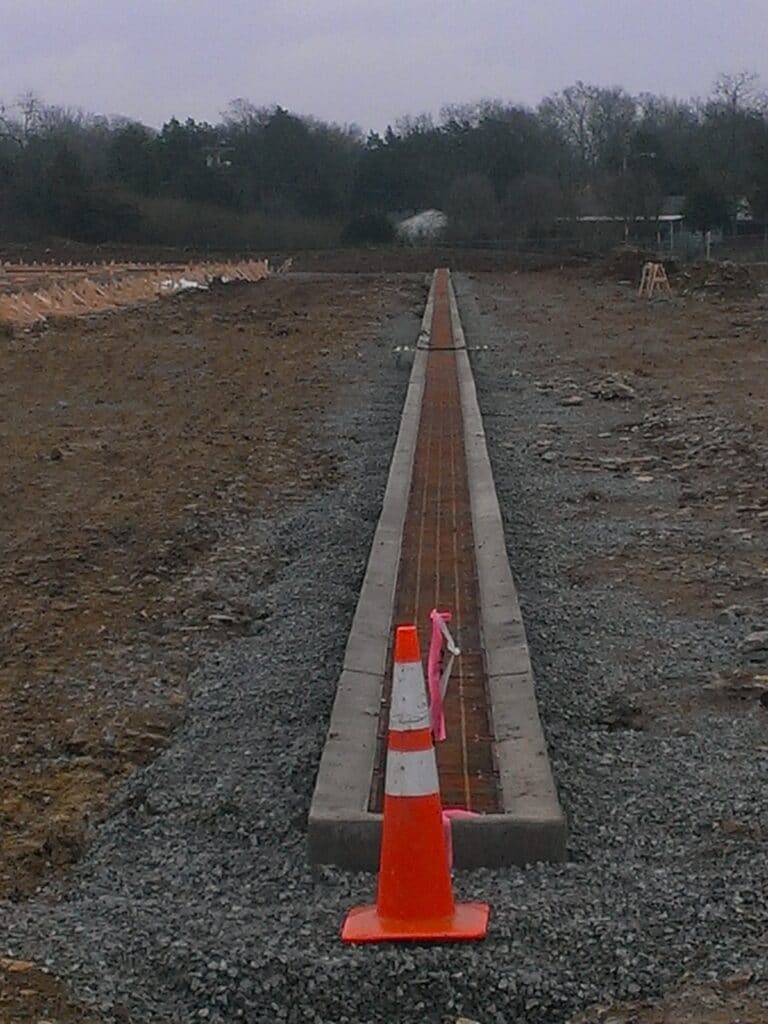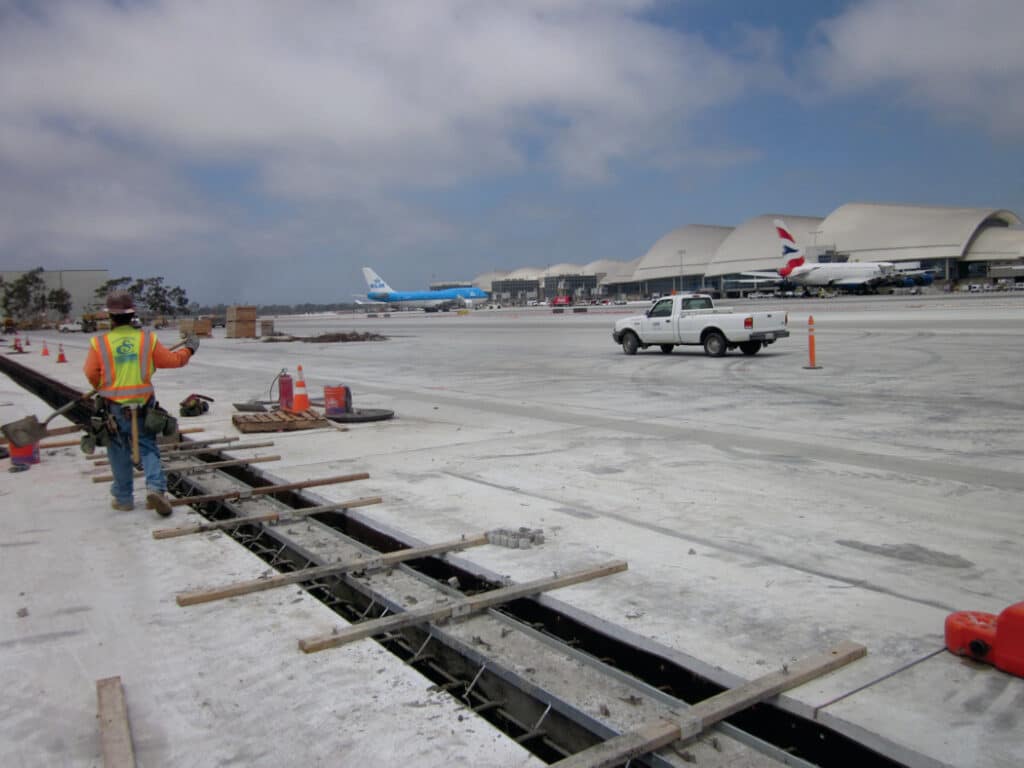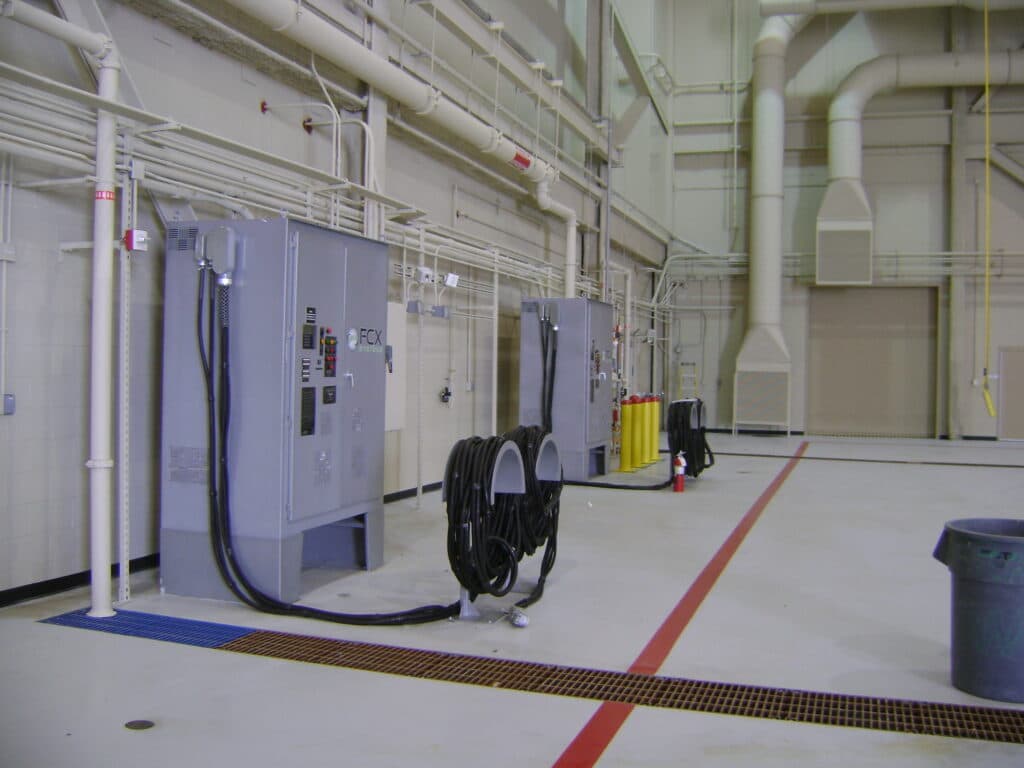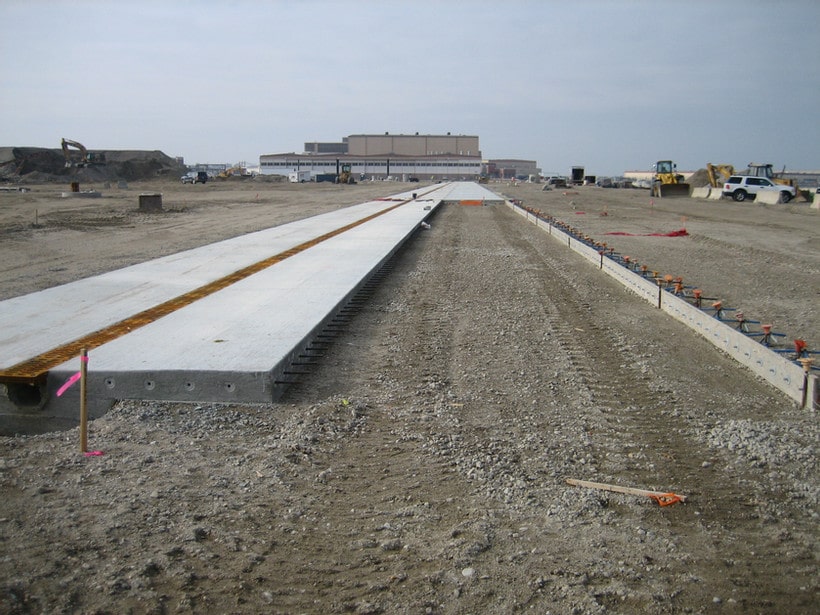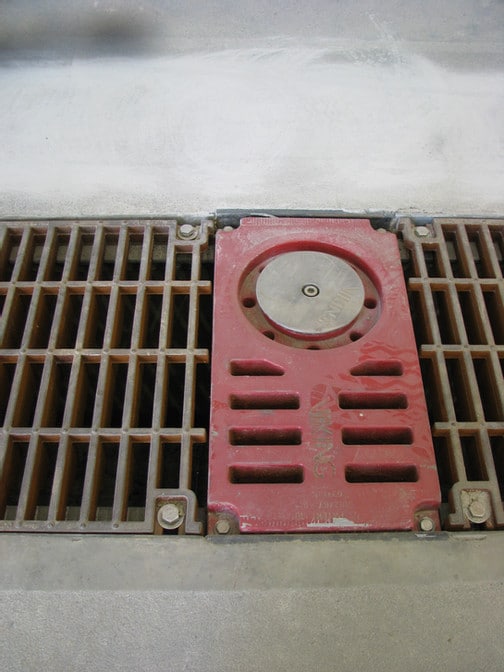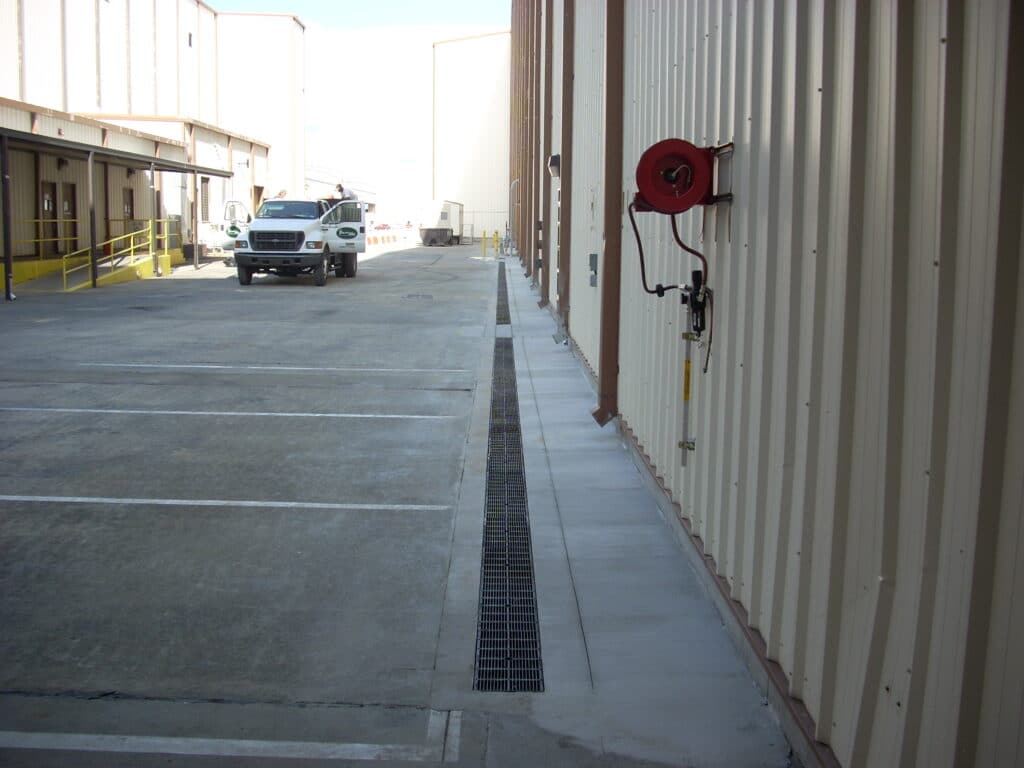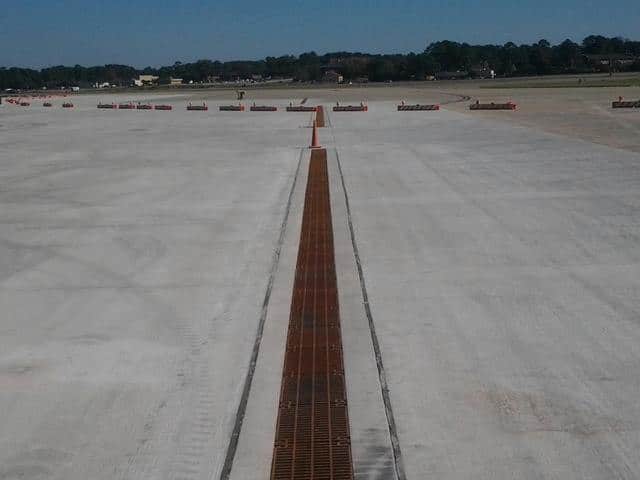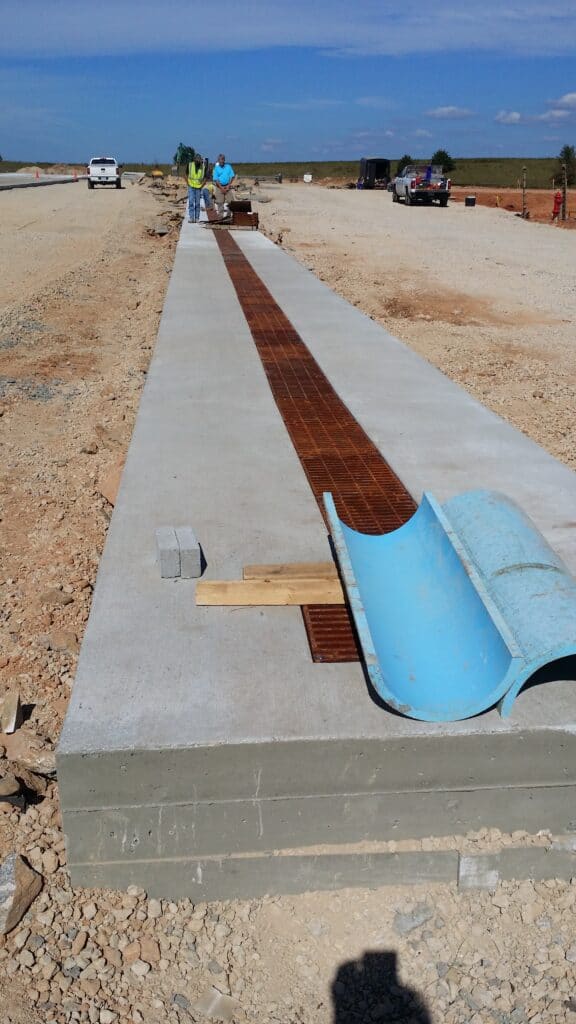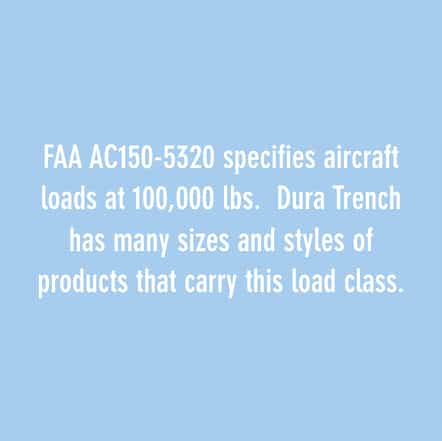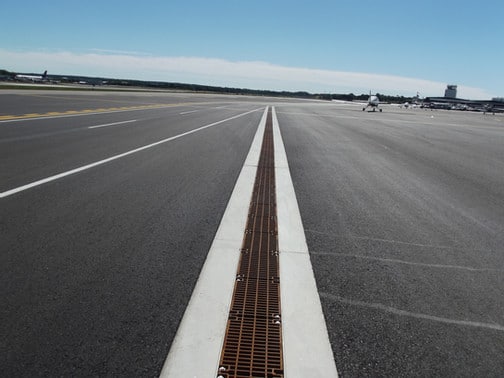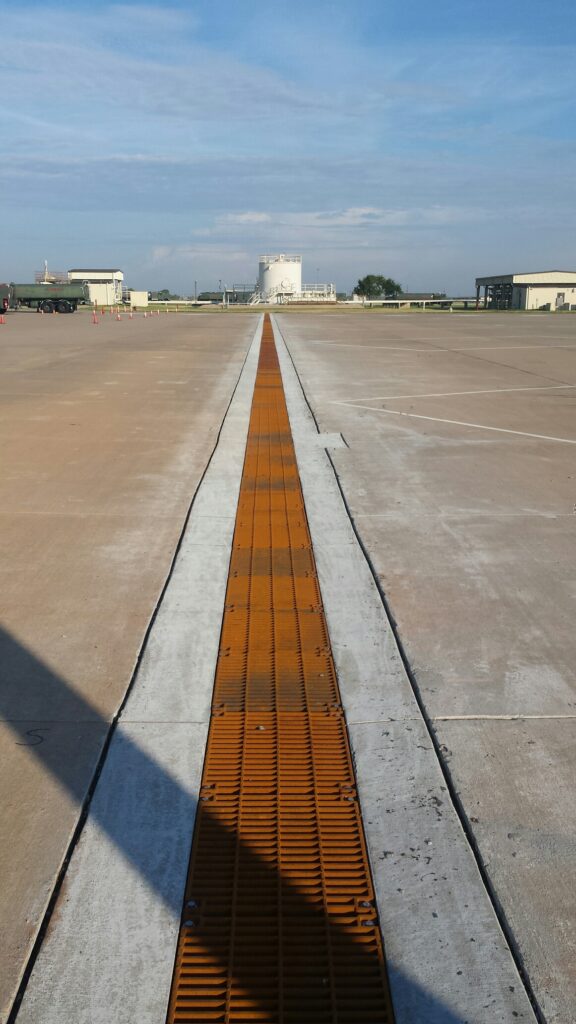Airport designs can vary significantly due to the size and nature of the project. Trench drains are a natural fit for airport projects because there is often little or no longitudinal slope to the sites. Trench drains can provide slope inside the channels to evacuate water from this type of site without complex grading. The most typical applications for airport trench drains are at hangar doors, inside the aircraft hangar, in the apron or taxiway, around de-icing areas, in terminal areas, vehicle parking areas, and in fueling and fuel storage areas.The size and strength of the trench drain can vary significantly depending on the location and depending on if it is a regional, military, or international airport.
Trench Drains and Slotted Drains for Airports & Aircraft Hangars
Design Considerations
Sizing the drain
- Trenches inside the hangar are typically of two types, one being utility trench for fire suppression lines, compressed air, electrical, or fuel. The other being a trench for drainage of the floor due to the fire suppression system, spills, and wash down water. For further design information on utility trenches use this link.
- For trench drains inside hangars you will typically be sizing the trench drain and outlet piping for the fire suppression system discharge. Often times the trench drains are not sized to remove 100% of the fire suppression liquid instantaneously. Sometimes the designs require that the liquid be removed within 5-10 minutes. Choose the length of time allowable and then use the flow rate charts to determine the proper size trench that you need for the application.
- For exterior applications, where you will be collecting storm water, you should use the minimum size that you calculate for the site. Over-sizing the drains will cause them to have a decreased flow velocity which will not allow them to reach cleaning velocities.
- Be sure that the outlet capacity does not limit the flow of the drain.
Choosing the channel
- If you are in a deicing or fueling area and the pavement will be coated with a chemical resistant coating then you should choose channels that have similar chemical resistance to that of the pavement coating. Often in these areas the chemicals are so diluted that the concrete is not coated and if it is not required to be coated then the drains also can be made of concrete or a light chemically resistant material (such as polyester fiberglass).
- In exterior applications you need to ensure that the drain will not degrade with exposure to ultraviolet light (UV light). Many larger airports use a fiberglass precast trench drain system or a concrete forming system so that they get a radius bottom.
- In municipal airports where loadings are lighter, precast systems are often chosen, however attention should still be paid to the consolidation of the concrete around the channels.
- The channels will receive various loadings depending on location and airport type. In military and international airports the channel can take severe loads. Be aware of the dynamic loads that can be placed on these systems. Often turning or breaking on the trench grates can transfer severe loads through the grates into the frame. A heavy duty or extreme duty frame is necessary on all but the smallest airports. The frame should have sufficient bearing area under it to support the entire wheel load. Several studies have been done that show the bearing area under the grate to be one of the leading causes of airport trench drain failures. Learn more about loading and material properties of grates and channels.
- Sealing channel joints is not necessary in this application unless you are in an area where the pavement is also being coated with a chemical resistant material. If the pavement is being coated make sure that the sealant you use can handle at least the same chemicals as the sealant for the pavement surface. If you want the joints properly sealed you must specify such and stress to the contractor that this be done properly. Stainless channels should be welded together with a continuous bead and then ground smooth. Polymer concrete and Fiberglass channels should be properly prepared by roughing up the joint and then using an appropriate two part sealant. HDPE channels should be welded together with a continuous heat welding process.
- Exterior applications or indoor applications that will not be temperature controlled will see severe changes in temperature and should have similar thermal coefficients of expansion to that of the surrounding concrete encasement.
Selecting the grate
- Grates for aircraft traffic need to be rated to handle the severe loadings that can be present under this type of traffic. For international airports the load rating is usually guided by the FAA to be 100, 0000 lbs for grating. Smaller airports should be guided by the type of aircraft that will be traversing the trench drain. Many of the smaller airports can use HS-25 rated grates.
- Make sure that the openings on the grate are as large as possible to ensure that clogging is not a factor. In aircraft traffic there should be little if any pedestrian traffic. The smaller the openings the more frequent cleaning of the grates will be necessary. The larger the openings the more likely the debris is to flush through the system.
- Always use ductile iron instead of cast iron in airport applications for the grates. Cast iron can have a brittle failure allowing the aircraft tire to fall through the grate.
- Grates should be locked down for jet aircraft applications. The most widely accepted lock down method are bolts at all four corners of the grates. Without proper locking of the grates the incredible force of the air behind the jets could lift and remove the grates causing a serious safety hazard.
Designing the layout
- Apron and taxiway trench drains at airports can be lengthy runs due to the flat longitudinal slope that is often present. Due to the long runs, be aware of the depths of the trench drain systems. Use systems that can handle the long runs or choose to have multiple outlets.
- The depth of the system that you are going to use can conflict with piping and other buried utilities.
- Outlets should be placed to minimize piping.
- The FAA requires fire breaks at 125′ to keep flammable liquids from spreading across apron areas. Break the trenches with high points leaving a concrete separation where required to meet this requirement.
- Trench drains at the hangar doors are typically placed just inside the track for the rolling doors to contain the fire suppression liquids. In some cases there is also a trench drain just outside the hangar doors to capture storm water. Remember that if you are going to connect into the sanitary system with a small diameter pipe, the trench capacity should match up with the capacity of the outlet piping. If you oversize the trench drain it will make the cost of the trench drain unnecessarily expensive.
What Are the Ratings Required for Drains at Airports?
There are various ratings that are required for drains that are used at airports. These requirements are for safety and must be complied with. You cannot install your drains and hope for the best if you want to be sure that your airport will pass inspections and be safe for those who fly in and out of them.
The ratings that you need to use for your drains are different depending on your location. There are various kinds of airports, and these locations have different drain settings. This is partly because of the kinds of planes and the volume of traffic that passes through larger airports.
County Airports
These locations are usually slated for a class D rating. This rating calls for a 4” wide iron grating, and a sloped system needs to be used. Smaller planes require smaller grates to prevent issues with wheels being caught in drains. The load rating needs to be D or E. This is the kind of location where high volumes of small planes pass through the airport each day, but drainage demands are not typically that high.
Municipal Airports
These airports are required to use iron grates as well, and they need to be 8” or 12” wide. Load ratings are rated for E or F. The runways at these locations are larger, and there are also bigger and heavier planes that pass through these airports. Small private plans might still use these runways and taxiways, so the drainage solutions need to be the right size for any kind of plane.
Sloped systems are a good choice here as well. This is often a space that is easier to set up than you might think. The mixed-use of these locations can dictate the level of drains that you need. You might not need to put in the larger drains that were discussed if your airport does not have larger planes that come through.
International Airports
This is the most complex kind of airport to plan drainage for. These airports will service all kinds of large planes, all kinds of small planes, and unique planes of all kinds. Helicopters might come through these airports as well.
Large airports will need to have 12” or 14” wide drains at a minimum, but you might even need larger drainage solutions. These drains will usually need more open slot covers to allow drain water to flow off large runway areas for safety.
Another feature of this kind of drain system is that it will need bolts that will hold the grates in place so that they are not sucked up into airplanes that are passing over them. This location will call for a class E or F rating, and the channels at some of these airports can be as large as a yard deep.
Bolting Mechanisms
No matter what size airport you are providing drainage for, you will need bolting systems in place to keep the drain covers on as planes pass over them. There is a significant security risk related to unsecured drain covers, and when you are planning drains for a larger airport, the drain covers could even be sucked into plane engines.
Bolting needs to be reinforced and durable so that it will not break down due to wet, snow, or other challenges. Airplane tires are not that large, but jet engines and propellers can cause a significant impact on the ground beneath them. This is why the bolting mechanisms that are in place for your drains need to be able to hold up to the demands of plane traffic.
Slot Drains Are a Great Choice
Slot drains are the standard choice for airport use. This is because they do not require grates and therefore save you the concern of applying bolts and other security fixtures to your drainage solutions. These drains also handle a lot of runoff without issue and are not likely to get clogged. Standing water on runways is a major safety issue, and you do not want to have to deal with this challenge which can shut down runways indefinitely until the water is removed.
Small local airports will often elect to use drains with slotted covers to save money, which is a reasonable solution when you only have very small planes passing over the areas with installed drainage. These smaller drains will still need to be bolted and reinforced protection to keep covers in place, however.
Slot drains are a really good fit for hangar use as well since they can be installed along the center of the floor without requiring grating to be placed over them. Slot drains are also very helpful along walkways and in common areas that might have traffic from luggage carts and support vehicles. There are many reasons why slot drains are such a popular choice, and if you have the ability to add these drains to your airport spaces, you should choose to invest in them.
Slot drainage is a very good choice based on practicality, but it can be hard to retrofit these drains to the existing runway and hangar spaces. This is often one of the limitations that can make drainage system planning tough at older airports that need upgrades. If the time can be taken to add these larger drains with slotted access, the improvements to safety are worth the invested time and runway closures.
Slot drains are also much easier to care for than other drainage types, and this can help make sure that your runways and common areas are never a source of added cost for drain repairs or cleaning. Drainage of all kinds requires maintenance, but slot drains are very practical and are made to be low maintenance and easy to care for.
Slot Drains on Walkways
Drainage in airport walkways can be regular trench-style drains with slotted covers. However, if these areas are adjacent to planes under power, the same bolting system will be needed to prevent covers from being removed from the drains or sucked into plane engines. This means that regular slot drains with covers that are not secured will have to be confined to parking lot areas and walkways away from the runway.
This is a common choice in airports that have walk-up plane boarding, but the slot drains will usually end when the plane taxiway areas are reached. Being sure that you are not exposing planes or passengers to risks is important. Having an expert assist in this kind of planning can be key to making sure that common spaces and walkways that are adjacent to places where planes operate are safe.
There is always more to consider than just foot traffic in areas that are right alongside the runway, and luggage carts, service vehicles, and other heavy items might have to pass over these drains as well. This means that plastic drain covers will not be a good choice and might not even be allowed to be used in these areas. If you have walkways on the front side of the airport that are covered with plastic drain covers, that is likely just fine. However, in spaces where vehicles and planes are being operated, you will need durable and reinforced drain covers that are not going to be lifted or removed, or broken due to heavy items passing over them.
Running drainage alongside walkways is always better than having these drains cross the walkway itself. This is because luggage and wheelchairs will need to pass over these parts of the walkway and could get caught in large drain covers. You might want to consider adding slot drains for areas that need to bisect walkways to make sure that safety is maintained. There are ADA-approved slot drain covers as well, which will not catch heeled shoes, luggage wheels, or wheelchair tires.
Drainage at Airports Has to Meet Standards
There are many considerations that go into the drainage planning for airports. These considerations are often governed by regulations. Safety and security are major issues at all airports, and making sure that drainage solutions work perfectly and are safe to have in place near airplanes is critical in this environment.
Drainage at the airport cannot be installed without making sure that it conforms to set standards, but there can also be limitations related to the existing condition of drainage at the airport and the potential for interrupted air travel due to improvements that need to be made. Installing quality drainage is really important for any airport location, and the shutdown time to get the right drains installed is often worth it when safety and convenience are considered.
Hydroplaning is a serious concern on runways in any location, even if rain and water runoff are not a common issue for the area of the particular airport. Water cannot be allowed to stand on runways, and correct drainage must be in place for the safe operation of the airport to continue on a daily basis. This is why a short shut down to upgrade drainage performance is so necessary in some cases. While it might be difficult to shut an airport down for a brief time, the rewards of having secure runways with excellent drainage are well worth it.

